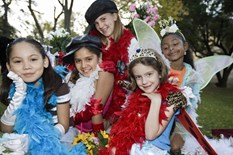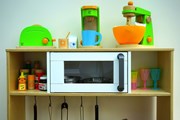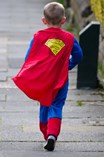Through pretend play children learn to express themselves and practice adult and cultural roles.

Children start by pretending to do everyday activities, they then participate and play with figures/dolls/teddies. They then link pretend play into action sequences and finally join in pretend games with other children.
 Babies and toddlers start with pretending to use objects for their given purpose e.g. they will pretend to drink from a cup or use a brush to brush their hair.
Babies and toddlers start with pretending to use objects for their given purpose e.g. they will pretend to drink from a cup or use a brush to brush their hair.
They then start to pretend with other objects. A banana might be a phone in their play.
Offering your child lots of access to everyday objects supports the development of their pretend play skills. Let them help you with everyday activities too.
Toddlers and young children then begin to play with dolls, teddies and/or action figures. Again this often starts with them copying everyday activities e.g. feeding the baby, dressing the teddy.

 Simple pretend sequences become more complex and children begin to act out action sequences. For example making a meal and sharing it with their toys.
Simple pretend sequences become more complex and children begin to act out action sequences. For example making a meal and sharing it with their toys.
 Children start to be able to pretend with other children. They have a shared understanding of the imaginary world and each takes on a role within that world.
Children start to be able to pretend with other children. They have a shared understanding of the imaginary world and each takes on a role within that world.